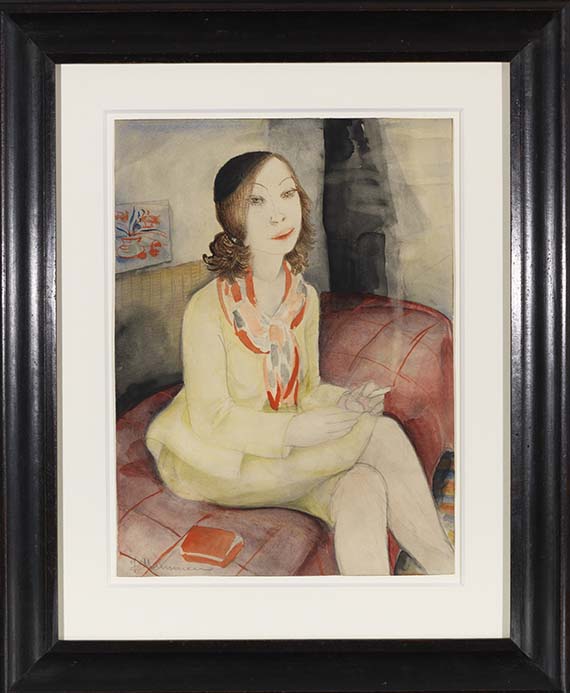Frame image
443
Jeanne Mammen
Meditation, Um 1930.
Watercolor and pencil drawing
Estimate:
€ 40,000 / $ 44,000 Sold:
€ 57,500 / $ 63,250 (incl. surcharge)
Meditation. Um 1930.
Watercolor and pencil drawing.
Döpping/Klünner A 370. Signed in lower left. On wove paper. 41 x 30.1 cm (16.1 x 11.8 in), the full sheet.
[CH].
• Jeanne Mammen is considered a chronicler of the bourgeois as well as of the shady sides of Berlin in the 1920s and 1930s.
• First published in 1930 in the magazine "Jugend".
• In 2017 part of the big retrospective "Jeanne Mammen. Die Beobachterin" at the Berlinische Galerie, Museum für Moderne Kunst.
PROVENANCE: Collection Georg and Wilhelm Denzel, Munich (verso with the collection stamp, not in Lugt).
Collection Dr. Friedrich Wilhelm Denzel, Munich (with the hand-inscribed collection stamp on the mount, not in Lugt).
Private collection Southern Germany.
EXHIBITION: Jeanne Mammen, Die Beobachterin. Retrospektive 1910-1975, Berlinische Galerie, Museum für Moderne Kunst, Berlin, October 6, 2017 - January 15, 2018, cat. no. 100 (on the back cover of the exhibition catalog and with a full-page illu. on p. 62).
Umbruch. Kunsthalle Mannheim, July 17 - October 18, 2020, p. 79 (with full-page color illu.).
LITERATURE: Jugend, issue 49, 35th year, November 1930, p. 778 (with black-and-white illu.).
Förderverein der Jeanne-Mammen-Stiftung e. V., Berlin (editor), Jeanne Mammen. Paris Bruxelles Berlin, Munich 2016, p. 54 (with full-page color illu.).
Watercolor and pencil drawing.
Döpping/Klünner A 370. Signed in lower left. On wove paper. 41 x 30.1 cm (16.1 x 11.8 in), the full sheet.
[CH].
• Jeanne Mammen is considered a chronicler of the bourgeois as well as of the shady sides of Berlin in the 1920s and 1930s.
• First published in 1930 in the magazine "Jugend".
• In 2017 part of the big retrospective "Jeanne Mammen. Die Beobachterin" at the Berlinische Galerie, Museum für Moderne Kunst.
PROVENANCE: Collection Georg and Wilhelm Denzel, Munich (verso with the collection stamp, not in Lugt).
Collection Dr. Friedrich Wilhelm Denzel, Munich (with the hand-inscribed collection stamp on the mount, not in Lugt).
Private collection Southern Germany.
EXHIBITION: Jeanne Mammen, Die Beobachterin. Retrospektive 1910-1975, Berlinische Galerie, Museum für Moderne Kunst, Berlin, October 6, 2017 - January 15, 2018, cat. no. 100 (on the back cover of the exhibition catalog and with a full-page illu. on p. 62).
Umbruch. Kunsthalle Mannheim, July 17 - October 18, 2020, p. 79 (with full-page color illu.).
LITERATURE: Jugend, issue 49, 35th year, November 1930, p. 778 (with black-and-white illu.).
Förderverein der Jeanne-Mammen-Stiftung e. V., Berlin (editor), Jeanne Mammen. Paris Bruxelles Berlin, Munich 2016, p. 54 (with full-page color illu.).
The works of Jeanne Mammen shape our conception of big city life, society, fashion and especially of the modern woman in the Weimar Republic up until today. The artist often also depicted the lives of those forgotten by society, portraying the socially disadvantaged, and does not just shows the chic city life of the 1920s, but also the life behind the scenes of variety shows, cabarets, ballrooms, bars and brothels - and directs the observer’s eye to the darker and remote side of the life of the Berliners. Her work never takes on a judgemental or even derogatory tone; Mammen rather renders her observations and in subtle representations, characterized by a critical sympathy, that do not seem unusual at first sight, and which can do without any notions of lurid drama. Even in this intimate scene of a woman sitting on a narrow bed, smoking and apparently lost in thought, there may be hints that give the initially unspectacular events the socio-critical undertone that is so typical of Mammen's work. The bed, the ominously black, shadowy background and the apparently nervous, cramped fingers of the depicted person who is entirely rapt yet very neatly dresses, may indicate that she, in view of the then increasing deterioration of the political, social and economic situation and the rising unemployment figures, may have had to look for a completely new job in order to make ends meet. Her face looks almost mask-like, emotionless, distressed, whilethe tulips on the picture on the wall begin to lose their petals. When the National Socialists came to power, Mammen's career came to an abrupt and early end. With the awareness of today's debates about equality and the role of women in society, the timeless relevance of Jeanne Mammen's works becomes all the more striking. Her strong, self-confident protagonists, as well as the quiet ones portrayed with doubt and lost in thought, as it is the case in the work offered here, address an important social issue that has not even been finally clarified today. Perhaps this is one of the reasons why the artist has been attracting greater attention over recent years. In the course of the comprehensive reassessment of the contributions female artists made to art history, the work of the Berlin artist Jeanne Mammen has moved into the focus of museums, institutions and the art trade. For example, in 2008 a solo exhibition was dedicated to her at the Paula Modersohn-Becker Museum in Bremen. A major retrospective at the Berlinische Galerie in Berlin followed in 2017, in which the work presented here was also prominently exhibited. [CH]
443
Jeanne Mammen
Meditation, Um 1930.
Watercolor and pencil drawing
Estimate:
€ 40,000 / $ 44,000 Sold:
€ 57,500 / $ 63,250 (incl. surcharge)


 Lot 443
Lot 443 
